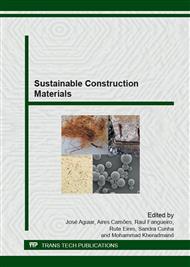[1]
C.E. Teixeira, Évolution biochimique des résidus de désencrage dans un contexte de valorisation comme barrière de recouvrement, PhD thesis, Département de génie civil, Université de Sherbrooke, Québec, 2001, p.195.
Google Scholar
[2]
D.S. Leidel, Sand reuse: user requirements, Modern Casting, Ontário, 83 (1993) 38-39.
Google Scholar
[3]
G. Pauli, Pollution-zéro, Les nouvelles grappes industrielles, Écodécision, printemps, (1995) 26-30.
Google Scholar
[4]
I.Z. Bribián, A.V. Capilla, A.A. Usón, Life cycle assessment of building materials: Comparative analysis of energy and environmental impacts and evaluation of the eco-efficiency improvement potential, Build. Environ., 46 (2011) 1133–1140.
DOI: 10.1016/j.buildenv.2010.12.002
Google Scholar
[5]
J. Caponero, Behavior of phosphate sludge in the production of Portland cement clinker, MSc thesis, Metallurgic and Material Engineering, Escola Politécnica, São Paulo, SP, Brazil, 1999, p.116. [In Portuguese. ].
Google Scholar
[6]
S.N. Paiva. A composite of cement and sludge obtained after treatment of effluents in a paper company, MSc thesis, Escola Superior de Agricultura Luiz de Queiroz (ESALQ) DA Universidade de São Paulo, 2007, p.111. [In Portuguese. ].
DOI: 10.11606/9788586481369
Google Scholar
[7]
P.O. Giffoni, L.C. Lange, The use of phosphate sludge as an alternative raw material in the manufacturing of bricks. Eng. Sanit. Ambient. 10 (2005) 128-136. ISSN 1413-4152.
Google Scholar
[8]
L.C.S. Hereka, C.E. Horib, M.H.M. Reisb, N.D. Morac, C.R.G. Tavaresd, R. Bergamascod, Characterization of ceramic bricks incorporated with textile laundry sludge, Cer. Int. 38, (2012).
Google Scholar
[9]
M. Arsenovic, Z. Radojevic, S. Stankovic, Removal of toxic metals from industrial sludge by fixing in brick structure, Cons. Buil. Mat. 37 (2012) 7-14.
DOI: 10.1016/j.conbuildmat.2012.07.002
Google Scholar
[10]
ASSOCIAÇÃO BRASILEIRA DE NORMAS TÉCNICAS. Resíduos sólidos – Classificação: NBR 10004. Rio de Janeiro (2004).
Google Scholar
[11]
F.A. Brehm, R.A. Bersch, D. Collatto, C.A.M. Moares, C. Kazmierczak, A. Pampanelli, K. Roxo, V. Rodrigues, E. Liedke, Recycling of phosphate sludge as admixture to red clay, in: Congresso Anual da ABM, 62, Vitória, Anais do 62º Congresso Anual da ABM, Vitória, 2007, pp.2115-2126.
DOI: 10.5151/1516-392x-2016
Google Scholar
[12]
ASSOCIAÇÃO BRASILEIRA DE NORMAS TÉCNICAS. Componentes Cerâmicos Parte 1: Blocos cerâmicos para alvenaria de vedação – Terminologia e requisitos: NBR 15270-1. Rio de Janeiro (2005). [In Portuguese. ].
DOI: 10.22410/issn.2176-3070.v10i4a2018.2009
Google Scholar
[13]
ASSOCIAÇÃO BRASILEIRA DE NORMAS TÉCNICAS. Componentes Cerâmicos Parte 3: Blocos cerâmicos para alvenaria estrutural e de vedação – Métodos de ensaio: NBR 15270-3. Rio de Janeiro (2005). [In Portuguese. ].
DOI: 10.22410/issn.2176-3070.v10i4a2018.2009
Google Scholar
[14]
ASSOCIAÇÃO BRASILEIRA DE NORMAS TÉCNICAS. Lixiviação de resíduos – Procedimentos: NBR 10005. Rio de Janeiro (2004). [In Portuguese. ].
Google Scholar
[15]
ASSOCIAÇÃO BRASILEIRA DE NORMAS TÉCNICAS. Solubilização de resíduos – Procedimentos: NBR 10006. Rio de Janeiro (2004). [In Portuguese. ].
Google Scholar
[16]
ASSOCIAÇÃO BRASILEIRA DE NORMAS TÉCNICAS. Resíduos sólidos – Classificação: NBR 10004. Rio de Janeiro (2004). [In Portuguese. ].
Google Scholar
[17]
F.A. Brehm, M.P. Kulakowski, D.C. Evaldt, C.A.M. Moraes, A.B. Pampanelli, Analysis of stabilization by solidification of phosphate sludge in Portland cement and red clay for use in the construction industry, Amb. Constr. 13 (2013).
Google Scholar
[18]
C-H. Weng, D-F. Lin, P-C. Chiang, Utilization of sludge as brick materials, Adv. Env. Res. 7 (2003) 679-685.
Google Scholar
[19]
J.A. Cusidó, L.V. Cremades, Environmental effects of using clay bricks produced with sewage sludge: Leachability and toxicity studies, Waste Manag. 32 (2012) 1202-1208.
DOI: 10.1016/j.wasman.2011.12.024
Google Scholar
[20]
M.M.S. Paula, V. Lorenzi, L. Silva, M.A. Fiori, A.M. Bernardin, Leaching and solubility analysis of porcelain-recycled tile residues in clay bricks, Int. J. Appl. Ceram. Technol. 7, (2010) 256-262.
DOI: 10.1111/j.1744-7402.2008.02343.x
Google Scholar


